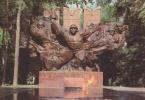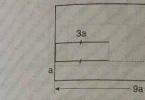Signs of parallelism of two lines
Theorem 1. If at the intersection of two lines of a secant:
diagonally lying angles are equal, or
corresponding angles are equal, or
the sum of one-sided angles is 180°, then
lines are parallel(Fig. 1).
Proof. We restrict ourselves to the proof of case 1.
Suppose that at the intersection of lines a and b by a secant AB across the lying angles are equal. For example, ∠ 4 = ∠ 6. Let us prove that a || b.
Assume that lines a and b are not parallel. Then they intersect at some point M and, consequently, one of the angles 4 or 6 will be the external angle of the triangle ABM. Let, for definiteness, ∠ 4 be the outer corner of the triangle ABM, and ∠ 6 be the inner one. It follows from the theorem on the external angle of a triangle that ∠ 4 is greater than ∠ 6, and this contradicts the condition, which means that the lines a and 6 cannot intersect, therefore they are parallel.
Corollary 1. Two distinct lines in a plane perpendicular to the same line are parallel(Fig. 2).
Comment. The way we just proved case 1 of Theorem 1 is called the method of proof by contradiction or reduction to absurdity. This method got its first name because at the beginning of the reasoning, an assumption is made that is opposite (opposite) to what is required to be proved. It is called reduction to absurdity due to the fact that, arguing on the basis of the assumption made, we come to an absurd conclusion (absurdity). Receiving such a conclusion forces us to reject the assumption made at the beginning and accept the one that was required to be proved.
Task 1. Construct a line passing through a given point M and parallel to a given line a, not passing through the point M.
Solution. We draw a line p through the point M perpendicular to the line a (Fig. 3).
Then we draw a line b through the point M perpendicular to the line p. The line b is parallel to the line a according to the corollary of Theorem 1.
An important conclusion follows from the considered problem:
Through a point not on a given line, one can always draw a line parallel to the given line..
The main property of parallel lines is as follows.
Axiom of parallel lines. Through a given point not on a given line, there is only one line parallel to the given line.
Consider some properties of parallel lines that follow from this axiom.
1) If a line intersects one of the two parallel lines, then it intersects the other (Fig. 4).
2) If two different lines are parallel to the third line, then they are parallel (Fig. 5).
The following theorem is also true.
Theorem 2. If two parallel lines are crossed by a secant, then:
the lying angles are equal;
corresponding angles are equal;
the sum of one-sided angles is 180°.
Consequence 2. If a line is perpendicular to one of two parallel lines, then it is also perpendicular to the other.(see Fig.2).
Comment. Theorem 2 is called the inverse of Theorem 1. The conclusion of Theorem 1 is the condition of Theorem 2. And the condition of Theorem 1 is the conclusion of Theorem 2. Not every theorem has an inverse, i.e. if a given theorem is true, then the inverse theorem may be false.
Let us explain this with the example of the theorem on vertical angles. This theorem can be formulated as follows: if two angles are vertical, then they are equal. The inverse theorem would be this: if two angles are equal, then they are vertical. And this, of course, is not true. Two equal angles do not have to be vertical at all.
Example 1 Two parallel lines are crossed by a third. It is known that the difference between two internal one-sided angles is 30°. Find those angles.
Solution. Let figure 6 meet the condition.
CHAPTER III.
PARALLEL LINES
§ 35. SIGNS OF PARALLELITY OF TWO DIRECT LINES.
The theorem that two perpendiculars to one line are parallel (§ 33) gives a sign that two lines are parallel. It is possible to derive more general signs of parallelism of two lines.
1. The first sign of parallelism.
If, at the intersection of two lines with a third, the interior angles lying across are equal, then these lines are parallel.
Let lines AB and CD intersect line EF and / 1 = / 2. Take the point O - the middle of the segment KL of the secant EF (Fig. 189).
Let us drop the perpendicular OM from the point O to the line AB and continue it until it intersects with the line CD, AB_|_MN. Let us prove that CD_|_MN.
To do this, consider two triangles: MOE and NOK. These triangles are equal to each other. Indeed: /
1 = /
2 by the condition of the theorem; OK = OL - by construction;
/
MOL = /
NOK as vertical corners. Thus, the side and two angles adjacent to it of one triangle are respectively equal to the side and two angles adjacent to it of another triangle; Consequently, /\
MOL = /\
NOK, and hence
/
LMO = /
kno but /
LMO is direct, hence, and /
KNO is also direct. Thus, the lines AB and CD are perpendicular to the same line MN, hence they are parallel (§ 33), which was to be proved.
Note. The intersection of the lines MO and CD can be established by rotating the triangle MOL around the point O by 180°.
2. The second sign of parallelism.
Let's see if the lines AB and CD are parallel if, at the intersection of their third line EF, the corresponding angles are equal.
Let some corresponding angles be equal, for example /
3 = /
2 (dev. 190);
/
3 = /
1, as the corners are vertical; means, /
2 will be equal /
1. But angles 2 and 1 are internal crosswise angles, and we already know that if at the intersection of two straight lines by a third, the internal crosswise lying angles are equal, then these lines are parallel. Therefore, AB || CD.
If at the intersection of two lines of the third the corresponding angles are equal, then these two lines are parallel.

The construction of parallel lines with the help of a ruler and a drawing triangle is based on this property. This is done as follows.
Let us attach the triangle to the ruler as shown in drawing 191. We will move the triangle so that one of its sides slides along the ruler, and draw several straight lines along any other side of the triangle. These lines will be parallel.
3. The third sign of parallelism.
Let us know that at the intersection of two lines AB and CD by the third line, the sum of any internal one-sided angles is equal to 2 d(or 180°). Will the lines AB and CD be parallel in this case (Fig. 192).

Let /
1 and /
2 interior one-sided angles and add up to 2 d.
But /
3 + /
2 = 2d as adjacent angles. Consequently, /
1 + /
2 = /
3+ /
2.
From here / 1 = / 3, and these corners are internally lying crosswise. Therefore, AB || CD.
If at the intersection of two lines by a third, the sum of the interior one-sided angles is equal to 2 d, then the two lines are parallel.
An exercise.
Prove that the lines are parallel:
a) if the external cross-lying angles are equal (Fig. 193);
b) if the sum of external unilateral angles is 2 d(devil 194).
This chapter is devoted to the study of parallel lines. This is the name given to two straight lines in a plane that do not intersect. We see segments of parallel lines in the environment - these are two edges of a rectangular table, two edges of a book cover, two trolleybus bars, etc. Parallel lines play a very important role in geometry. In this chapter, you will learn about what the axioms of geometry are and what the axiom of parallel lines consists of - one of the most famous axioms of geometry.
In Section 1, we noted that two lines either have one common point, that is, they intersect, or they do not have a single common point, that is, they do not intersect.
Definition
The parallelism of lines a and b is denoted as follows: a || b.
Figure 98 shows lines a and b perpendicular to line c. In Section 12 we established that such lines a and b do not intersect, that is, they are parallel.
Rice. 98
Along with parallel lines, parallel segments are often considered. The two segments are called parallel if they lie on parallel lines. In figure 99, and the segments AB and CD are parallel (AB || CD), and the segments MN and CD are not parallel. Similarly, the parallelism of a segment and a straight line (Fig. 99, b), a ray and a straight line, a segment and a ray, two rays (Fig. 99, c) is determined.

Rice. 99 Signs of parallelism of two lines
Direct with is called secant with respect to lines a and b, if it intersects them at two points (Fig. 100). At the intersection of lines a and b, the secant c forms eight angles, which are indicated by numbers in Figure 100. Some pairs of these angles have special names:
criss-cross corners: 3 and 5, 4 and 6;
one-sided corners: 4 and 5, 3 and 6;
corresponding angles: 1 and 5, 4 and 8, 2 and 6, 3 and 7.

Rice. 100
Consider three signs of parallelism of two lines associated with these pairs of angles.
Theorem
Proof
Suppose that at the intersection of lines a and b by a secant AB, the lying angles are equal: ∠1 = ∠2 (Fig. 101, a).
Let us prove that a || b. If angles 1 and 2 are right (Fig. 101, b), then the lines a and b are perpendicular to the line AB and, therefore, parallel.

Rice. 101
Consider the case when angles 1 and 2 are not right.
From the middle O of the segment AB, draw a perpendicular OH to the straight line a (Fig. 101, c). On the line b from point B, we set aside the segment VH 1, equal to the segment AH, as shown in Figure 101, c, and draw the segment OH 1. Triangles ONA and OH 1 V are equal in two sides and the angle between them (AO = BO, AN = VN 1, ∠1 = ∠2), therefore ∠3 = ∠4 and ∠5 = ∠6. From the equality ∠3 = ∠4 it follows that the point H 1 lies on the continuation of the ray OH, i.e. the points H, O and H 1 lie on the same straight line, and from the equality ∠5 = ∠6 it follows that the angle 6 is a straight line (since angle 5 is a right angle). So lines a and b are perpendicular to line HH 1, so they are parallel. The theorem has been proven.
Theorem
Proof
Let at the intersection of lines a and b the secant with the corresponding angles be equal, for example ∠1 = ∠2 (Fig. 102).

Rice. 102
Since angles 2 and 3 are vertical, then ∠2 = ∠3. These two equalities imply that ∠1 = ∠3. But angles 1 and 3 are crosswise, so lines a and b are parallel. The theorem has been proven.
Theorem
Proof
Let, at the intersection of lines a and b, the secant with the sum of one-sided angles be 180°, for example ∠1 + ∠4 = 180° (see Fig. 102).
Since angles 3 and 4 are adjacent, then ∠3 + ∠4 = 180°. From these two equalities it follows that the crosswise angles 1 and 3 are equal, so the lines a and b are parallel. The theorem has been proven.
Practical Ways to Draw Parallel Lines
The signs of parallel lines underlie the ways of constructing parallel lines with the help of various tools used in practice. Consider, for example, a method for constructing parallel lines using a drawing square and a ruler. To build a straight line passing through the point M and parallel to the given line a, we apply a drawing square to the straight line a, and a ruler to it as shown in Figure 103. Then, moving the square along the ruler, we will ensure that the point M is on the side of the square , and draw a line b. The lines a and b are parallel, since the corresponding angles, denoted in Figure 103 by the letters α and β, are equal.
Rice. 103 Figure 104 shows a method for constructing parallel lines using a T-square. This method is used in drawing practice.

Rice. 104 A similar method is used when performing carpentry work, where a bevel is used to mark parallel lines (two wooden planks fastened with a hinge, Fig. 105).

Rice. 105
Tasks
186. In Figure 106, lines a and b are intersected by line c. Prove that a || b if:
a) ∠1 = 37°, ∠7 = 143°;
b) ∠1 = ∠6;
c) ∠l = 45°, and angle 7 is three times larger than angle 3.

Rice. 106
187. According to figure 107 prove that AB || D.E.

Rice. 107
188. Segments AB and CD intersect in their common middle. Prove that lines AC and BD are parallel.
189. Using the data in Figure 108, prove that BC || AD.

Rice. 108
190. In Figure 109 AB = BC, AD = DE, ∠C = 70°, ∠EAC = 35°. Prove that DE || AS.

Rice. 109
191. The segment VK is the bisector of the triangle ABC. A straight line is drawn through the point K, intersecting the side BC at the point M so that BM = MK. Prove that lines KM and AB are parallel.
192. In triangle ABC, angle A is 40°, and angle ALL adjacent to angle ACB is 80°. Prove that the bisector of angle ALL is parallel to line AB.
193. In triangle ABC ∠A = 40°, ∠B = 70°. Line BD is drawn through vertex B so that ray BC is the bisector of angle ABD. Prove that lines AC and BD are parallel.
194. Draw a triangle. Through each vertex of this triangle, using a drawing square and a ruler, draw a straight line parallel to the opposite side.
195. Draw triangle ABC and mark point D on side AC. Through point D, using a drawing square and a ruler, draw straight lines parallel to the other two sides of the triangle.
This chapter is devoted to the study of parallel lines. This is the name given to two straight lines in a plane that do not intersect. We see segments of parallel lines in the environment - these are two edges of a rectangular table, two edges of a book cover, two trolleybus bars, etc. Parallel lines play a very important role in geometry. In this chapter, you will learn about what the axioms of geometry are and what the axiom of parallel lines consists of - one of the most famous axioms of geometry.
In Section 1, we noted that two lines either have one common point, that is, they intersect, or they do not have a single common point, that is, they do not intersect.
Definition
The parallelism of lines a and b is denoted as follows: a || b.
Figure 98 shows lines a and b perpendicular to line c. In Section 12 we established that such lines a and b do not intersect, that is, they are parallel.
Rice. 98
Along with parallel lines, parallel segments are often considered. The two segments are called parallel if they lie on parallel lines. In figure 99, and the segments AB and CD are parallel (AB || CD), and the segments MN and CD are not parallel. Similarly, the parallelism of a segment and a straight line (Fig. 99, b), a ray and a straight line, a segment and a ray, two rays (Fig. 99, c) is determined.

Rice. 99 Signs of parallelism of two lines
Direct with is called secant with respect to lines a and b, if it intersects them at two points (Fig. 100). At the intersection of lines a and b, the secant c forms eight angles, which are indicated by numbers in Figure 100. Some pairs of these angles have special names:
criss-cross corners: 3 and 5, 4 and 6;
one-sided corners: 4 and 5, 3 and 6;
corresponding angles: 1 and 5, 4 and 8, 2 and 6, 3 and 7.

Rice. 100
Consider three signs of parallelism of two lines associated with these pairs of angles.
Theorem
Proof
Suppose that at the intersection of lines a and b by a secant AB, the lying angles are equal: ∠1 = ∠2 (Fig. 101, a).
Let us prove that a || b. If angles 1 and 2 are right (Fig. 101, b), then the lines a and b are perpendicular to the line AB and, therefore, parallel.

Rice. 101
Consider the case when angles 1 and 2 are not right.
From the middle O of the segment AB, draw a perpendicular OH to the straight line a (Fig. 101, c). On the line b from point B, we set aside the segment VH 1, equal to the segment AH, as shown in Figure 101, c, and draw the segment OH 1. Triangles ONA and OH 1 V are equal in two sides and the angle between them (AO = BO, AN = VN 1, ∠1 = ∠2), therefore ∠3 = ∠4 and ∠5 = ∠6. From the equality ∠3 = ∠4 it follows that the point H 1 lies on the continuation of the ray OH, i.e. the points H, O and H 1 lie on the same straight line, and from the equality ∠5 = ∠6 it follows that the angle 6 is a straight line (since angle 5 is a right angle). So lines a and b are perpendicular to line HH 1, so they are parallel. The theorem has been proven.
Theorem
Proof
Let at the intersection of lines a and b the secant with the corresponding angles be equal, for example ∠1 = ∠2 (Fig. 102).

Rice. 102
Since angles 2 and 3 are vertical, then ∠2 = ∠3. These two equalities imply that ∠1 = ∠3. But angles 1 and 3 are crosswise, so lines a and b are parallel. The theorem has been proven.
Theorem
Proof
Let, at the intersection of lines a and b, the secant with the sum of one-sided angles be 180°, for example ∠1 + ∠4 = 180° (see Fig. 102).
Since angles 3 and 4 are adjacent, then ∠3 + ∠4 = 180°. From these two equalities it follows that the crosswise angles 1 and 3 are equal, so the lines a and b are parallel. The theorem has been proven.
Practical Ways to Draw Parallel Lines
The signs of parallel lines underlie the ways of constructing parallel lines with the help of various tools used in practice. Consider, for example, a method for constructing parallel lines using a drawing square and a ruler. To build a straight line passing through the point M and parallel to the given line a, we apply a drawing square to the straight line a, and a ruler to it as shown in Figure 103. Then, moving the square along the ruler, we will ensure that the point M is on the side of the square , and draw a line b. The lines a and b are parallel, since the corresponding angles, denoted in Figure 103 by the letters α and β, are equal.
Rice. 103 Figure 104 shows a method for constructing parallel lines using a T-square. This method is used in drawing practice.

Rice. 104 A similar method is used when performing carpentry work, where a bevel is used to mark parallel lines (two wooden planks fastened with a hinge, Fig. 105).

Rice. 105
Tasks
186. In Figure 106, lines a and b are intersected by line c. Prove that a || b if:
a) ∠1 = 37°, ∠7 = 143°;
b) ∠1 = ∠6;
c) ∠l = 45°, and angle 7 is three times larger than angle 3.

Rice. 106
187. According to figure 107 prove that AB || D.E.

Rice. 107
188. Segments AB and CD intersect in their common middle. Prove that lines AC and BD are parallel.
189. Using the data in Figure 108, prove that BC || AD.

Rice. 108
190. In Figure 109 AB = BC, AD = DE, ∠C = 70°, ∠EAC = 35°. Prove that DE || AS.

Rice. 109
191. The segment VK is the bisector of the triangle ABC. A straight line is drawn through the point K, intersecting the side BC at the point M so that BM = MK. Prove that lines KM and AB are parallel.
192. In triangle ABC, angle A is 40°, and angle ALL adjacent to angle ACB is 80°. Prove that the bisector of angle ALL is parallel to line AB.
193. In triangle ABC ∠A = 40°, ∠B = 70°. Line BD is drawn through vertex B so that ray BC is the bisector of angle ABD. Prove that lines AC and BD are parallel.
194. Draw a triangle. Through each vertex of this triangle, using a drawing square and a ruler, draw a straight line parallel to the opposite side.
195. Draw triangle ABC and mark point D on side AC. Through point D, using a drawing square and a ruler, draw straight lines parallel to the other two sides of the triangle.
AB and FROMD crossed by the third line MN, then the angles formed in this case receive the following names in pairs:corresponding angles: 1 and 5, 4 and 8, 2 and 6, 3 and 7;
internal cross-lying corners: 3 and 5, 4 and 6;
external cross-lying corners: 1 and 7, 2 and 8;
internal one-sided corners: 3 and 6, 4 and 5;
external one-sided corners: 1 and 8, 2 and 7.
So, ∠ 2 = ∠ 4 and ∠ 8 = ∠ 6, but by the proven ∠ 4 = ∠ 6.
Therefore, ∠ 2 = ∠ 8.
3. Respective angles 2 and 6 are the same, since ∠ 2 = ∠ 4, and ∠ 4 = ∠ 6. We also make sure that the other corresponding angles are equal.
4. Sum internal one-sided corners 3 and 6 will be 2d because the sum adjacent corners 3 and 4 is equal to 2d = 180 0 , and ∠ 4 can be replaced by the identical ∠ 6. Also make sure that sum of angles 4 and 5 is equal to 2d.
5. Sum external one-sided corners will be 2d because these angles are equal respectively internal one-sided corners like corners vertical.
From the justification proved above, we obtain inverse theorems.
When, at the intersection of two lines of an arbitrary third line, we obtain that:
1. Internal cross lying angles are the same;
or 2. External cross lying angles are the same;
or 3. The corresponding angles are the same;
or 4. The sum of internal one-sided angles is equal to 2d = 180 0 ;
or 5. The sum of the outer one-sided is 2d = 180 0 ,
then the first two lines are parallel.




